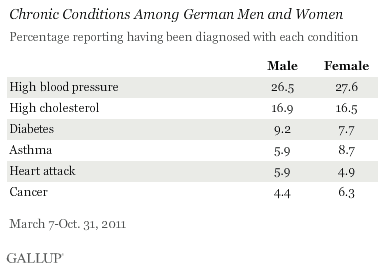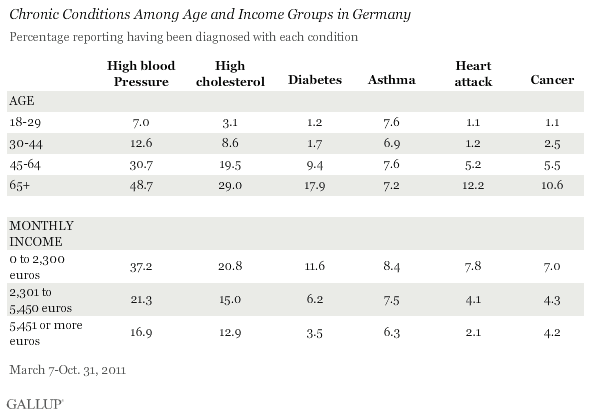BERLIN -- German adults are more likely to report having been diagnosed with high blood pressure at some point in their lives (27.1%) than various other chronic conditions, including high cholesterol (16.7%), diabetes (8.4%), asthma (7.4%), heart attack (5.4%), and cancer (5.4%).

Gallup tracks diagnoses of chronic conditions in Germany on a monthly basis as part of the Gallup-Healthways Well-Being Index, surveying approximately 1,000 German adults per month. Gallup asks respondents if a physician or nurse has ever diagnosed them with any of the conditions.
Highlighting important regional differences, in eastern Germany, more than a third of respondents report having been diagnosed with high blood pressure (35.9%), which is more than 10 percentage points higher than in western Germany (25.1%). The frequency of those reporting a diabetes diagnosis is also much higher in eastern Germany (12.9%) than it is in western Germany (7.3%). There is no meaningful difference between eastern and western Germany in terms of a diagnosis of high cholesterol, asthma, heart attacks, and cancer.
Overall, the German figures compare favorably with the U.S., where diagnosis rates on several chronic diseases -- except for heart attacks -- are higher than in Germany. In the U.K., significantly fewer people report diagnoses of high blood pressure (20.7%) than in Germany. However, more people report having been diagnosed with asthma (13.5%) in the U.K. than in Germany (7.4%).
Women More Likely to Report Asthma and Cancer Than Men
Women in Germany report statistically significant higher rates of asthma (8.7%) than men (5.9%). Also, more women report having been diagnosed with cancer (6.3%) than men (4.4%). The differences between men and women on diagnoses of high blood pressure, high cholesterol, diabetes, and heart attacks are not statistically significant.

Chronic Conditions More Prevalent Among Older and Lower Income Germans
The data show a higher prevalence of most chronic condition diagnoses among older respondents than among younger respondents, with 18- to 29-year-olds always reporting the lowest chronic conditions rates and those aged 65 and older always reporting the highest rates -- even after controlling for income. For example, while 7% of people aged 18 to 29 report having been diagnosed with high blood pressure, this proportion rises to 48.7% among people 65 years old and older. Differences in age are not statistically significant for an asthma diagnosis.
Lower income adults are more likely to report having been diagnosed with high blood pressure, diabetes, asthma, and heart attacks. High blood pressure diagnosis is more than 20 points higher among people making less than 2,300 euros per month than among those making more than 5,451 euros per month (37.2% vs. 16.9%). Lower income Germans are also three times as likely to report having been diagnosed with diabetes (11.6% vs. 3.5%) or heart attacks (7.8% vs. 2.1%) than those in the highest income group. These differences are still significant after controlling for age. Differences in monthly income are not statistically significant for high cholesterol and cancer diagnoses.

Research Gallup and Healthways conducted in the U.S. has found similar results on chronic conditions for lower income groups, reinforcing the health risks poorer people face.
Implications
More than a quarter of the adult population in Germany reports having been diagnosed with high blood pressure at some point in their lives, and many also report high cholesterol -- two conditions linked to other serious health conditions. High blood pressure and high cholesterol are also problems in the U.S. and the U.K.
Such chronic conditions are a major cost to individuals, businesses, and societies. They increase the burden on the healthcare system and lower workplace productivity and overall well-being.
Germany is facing the challenge of an aging population and an increasingly costly healthcare system. It is important for Germany's leaders to understand the underlying role chronic conditions play in Germans' lives and the regional and demographic differences that are apparent.
The behavioral data collected through the Gallup-Healthways Well-Being Index can inform this debate with detailed and timely information and thus help leaders in government, business, and civil society shape policies and outcomes that can improve all Germans' health.
About the Gallup-Healthways Well-Being Index
The Gallup-Healthways Well-Being Index tracks well-being in the U.S., U.K., and Germany and provides best-in-class solutions for a healthier world. To learn more, please visit well-beingindex.com.
View all Gallup-Healthways Well-Being Index questions and methodology.
Survey Methods
Results are based on telephone interviews conducted as part of the Gallup-Healthways Well-Being Index survey March 7-Oct. 31, 2011, with a random sample of 7,728 adults, aged 18 and older, living in Germany, selected using random-digit-dial sampling. For inter-country comparisons, this story uses data captured form March 1-Oct. 31, 2011. During this period, Gallup surveyed 7,839 Britons and 241,521 Americans.
For results based on the total sample of national adults, one can say with 95% confidence that the maximum margin of sampling error is ±1.5 percentage points in Germany, ±1.3 percentage points in the U.K., and less than ±1 percentage point in the U.S.
Interviews are conducted with respondents on landline telephones and cellular phones. Samples are weighted by gender, age, education, region, adults in household, and cell phone status. Demographic weighting targets are based on the most recently published population data from the German Statistics Office. All reported margins of sampling error include the computed design effects for weighting and sample design.
In addition to sampling error, question wording and practical difficulties in conducting surveys can introduce error or bias into the findings of public opinion polls.
For more details on Gallup's polling methodology, visit www.gallup.com.
